5 Essential Plants for a Thriving Water Garden Ecosystem
A water garden is more than just a beautiful addition to your outdoor space; it’s a living ecosystem that thrives on the interaction between water, plants, and wildlife. By carefully selecting the right plants for your water garden, you can create a balanced and sustainable environment that supports a diverse range of flora and fauna. In this guide, we’ll explore five essential plants that are crucial for building a thriving water garden ecosystem. From oxygenating plants that improve water quality to floating beauties that add visual interest, each of these plants plays a vital role in maintaining the health and vitality of your water garden.
- Water Lilies (Nymphaea spp.): No water garden is complete without the enchanting beauty of water lilies. These iconic aquatic plants are renowned for their elegant blooms, which float gracefully on the surface of the water. In addition to their aesthetic appeal, water lilies provide important shade and shelter for fish and other aquatic life. Their broad leaves help to reduce algae growth by blocking out sunlight, while their submerged stems provide a habitat for beneficial microorganisms. With a wide range of colors and varieties to choose from, water lilies are a must-have for any water garden enthusiast.
- Water Hyacinth (Eichhornia crassipes): Water hyacinth is a floating aquatic plant that adds both beauty and functionality to your water garden. Its distinctive round leaves and delicate purple flowers create a striking visual contrast against the still waters of a pond or lake. But beyond its aesthetic appeal, water hyacinth serves an important role in maintaining water quality. Its extensive root system helps to absorb excess nutrients from the water, thereby reducing the risk of algae blooms and improving overall water clarity. Water hyacinth is also a favorite food source for ducks and other waterfowl, making it a valuable addition to any aquatic ecosystem.
- Water Lettuce (Pistia stratiotes): Similar to water hyacinth, water lettuce is a floating plant that helps to regulate water quality and provide habitat for aquatic life. Its rosettes of light green leaves form dense mats on the surface of the water, providing shade and shelter for fish and other organisms. Like water hyacinth, water lettuce also helps to absorb excess nutrients from the water, making it an effective natural filter. In addition to its practical benefits, water lettuce adds a touch of whimsy to your water garden with its unique appearance and trailing roots.
- Pickerelweed (Pontederia cordata): Pickerelweed is a versatile perennial plant that thrives in both wet and dry conditions, making it an excellent choice for water gardens with fluctuating water levels. Its striking spikes of blue-purple flowers attract pollinators such as bees and butterflies, while its lance-shaped leaves provide shelter for fish and other aquatic creatures. Pickerelweed is also an important food source for waterfowl, providing nourishment for ducks, geese, and other birds. With its vibrant blooms and hardy nature, pickerelweed adds color and vitality to any water garden ecosystem.
- Anacharis (Egeria densa): Anacharis, also known as Brazilian elodea, is a fast-growing submerged plant that helps to oxygenate the water and improve overall water quality. Its long, trailing stems are covered in delicate, bright green leaves that provide habitat for small fish and invertebrates. Anacharis is an excellent choice for ponds and aquariums, where it helps to remove excess nutrients and provide a source of food and shelter for aquatic life. Easy to grow and maintain, anacharis is a valuable addition to any water garden ecosystem.
Check out our store for all your water gardening needs! Aquascape products are Aquascape Inc. Certified.
Thanks for reading at Meyer Aquascapes! We hope you’ve enjoyed our post on garden pond design. Please leave a comment below if you liked it or have any questions. We’d love to hear from you! Thanks for stopping by!


 Meyer Aquascapes
Meyer Aquascapes Meyer Aquascapes
Meyer Aquascapes